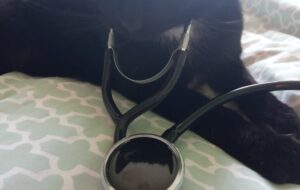Ear mites, scientifically known as Otodectes cynotis, are microscopic parasites that primarily inhabit the ear canals of cats, although they can also affect dogs and other animals. These tiny arachnids are not visible to the naked eye, making them particularly insidious. They thrive in the warm, dark environment of the ear canal, feeding on the wax and oils produced by the skin.
The presence of ear mites can lead to significant discomfort for the affected animal, as they cause irritation and inflammation in the ear. The life cycle of ear mites is relatively short, typically lasting about three weeks. Adult mites lay eggs in the ear canal, which hatch into larvae and then mature into adults.
This rapid reproduction can lead to a swift infestation if left untreated. Ear mites are highly contagious and can easily spread from one animal to another through direct contact. This is particularly common in multi-pet households or in environments where animals congregate, such as shelters or boarding facilities.
Understanding the biology and behavior of ear mites is crucial for effective prevention and treatment.
Key Takeaways
- Ear mites are tiny parasites that can infest a cat’s ear canal, causing irritation and discomfort.
- Symptoms of ear mite infestation in cats include excessive scratching, head shaking, and dark discharge in the ears.
- When choosing medication for ear mites, it’s important to consult a veterinarian to determine the most effective treatment for the cat.
- Topical medications, such as ear drops and ointments, are commonly used to treat ear mites in cats.
- Oral medications, such as pills or liquid medication, may be prescribed by a veterinarian to effectively treat ear mite infestations in cats.
Symptoms of Ear Mite Infestation in Cats
Behavioral Changes
One of the most common symptoms is excessive scratching or rubbing of the ears. Cats may shake their heads frequently or tilt them to one side in an attempt to alleviate the discomfort caused by the mites.
Physical Signs
Another telltale sign of ear mite infestation is the presence of dark, crumbly debris in the ear canal, often described as resembling coffee grounds. This debris consists of dead mites, skin cells, and wax, and its accumulation can lead to further irritation and inflammation.
Severe Cases
In more severe cases, cats may exhibit signs of pain or distress when their ears are touched, and there may be a noticeable odor emanating from the ears due to secondary bacterial infections. Observing these symptoms early on is essential for prompt treatment and to prevent complications.
Choosing the Right Medication for Ear Mites

When it comes to treating ear mite infestations in cats, selecting the appropriate medication is critical for effective eradication of the parasites. Various options are available, ranging from topical treatments to oral medications, each with its own set of advantages and potential drawbacks. The choice of medication often depends on factors such as the severity of the infestation, the cat’s overall health, and any underlying conditions that may complicate treatment.
Consulting with a veterinarian is essential before starting any treatment regimen. A veterinarian can perform a thorough examination of the cat’s ears and may take samples to confirm the presence of ear mites. This diagnostic step ensures that other potential issues, such as bacterial or yeast infections, are ruled out.
Once a diagnosis is confirmed, the veterinarian can recommend a suitable medication based on the specific needs of the cat and the severity of the infestation.
Topical Medications for Ear Mites
| Medication Name | Active Ingredient | Administration | Effectiveness |
|---|---|---|---|
| Tresaderm | Thiabendazole, Dexamethasone, Neomycin | Topical, 5-15 drops in the ear twice a day | Effective in treating ear mites in cats and dogs |
| Revolution | Selamectin | Topical, applied to the skin on the back of the neck | Effective in treating ear mites in cats and dogs |
| Milbemite | Milbemycin oxime | Topical, 2-4 drops in the ear once a day for 14 days | Effective in treating ear mites in cats |
Topical medications are among the most commonly prescribed treatments for ear mite infestations in cats. These products are typically applied directly into the ear canal and work by killing adult mites and preventing their eggs from hatching. One popular topical treatment is ivermectin, which is effective against a variety of parasites, including ear mites.
It is usually administered as a liquid solution that is instilled into the ear canal. Another effective topical option is selamectin, which is often delivered as a spot-on treatment applied to the skin at the back of the cat’s neck. This method allows for systemic absorption and provides protection against a range of parasites beyond just ear mites.
While topical treatments can be highly effective, they may require multiple applications over several weeks to ensure complete eradication of the infestation. Additionally, pet owners must be diligent about following dosage instructions to avoid underdosing or overdosing their cats.
Oral Medications for Ear Mites
Oral medications represent another viable option for treating ear mite infestations in cats. These medications work systemically to eliminate mites throughout the body rather than just targeting those present in the ears. One commonly used oral medication is milbemycin oxime, which is effective against various parasites, including ear mites.
This medication is typically administered as a tablet and may be combined with other treatments for comprehensive parasite control. While oral medications can be convenient for some pet owners, they may not be suitable for all cats, particularly those with underlying health issues or those that are pregnant or nursing. Additionally, oral treatments may take longer to show results compared to topical options since they rely on systemic absorption to reach effective concentrations in the body.
As with any medication, it is crucial to follow veterinary guidance regarding dosage and duration of treatment to ensure safety and efficacy.
Natural Remedies for Ear Mites

For pet owners seeking alternative approaches to treating ear mite infestations, several natural remedies may offer some relief. While these remedies may not be as scientifically validated as conventional treatments, some cat owners report success with them. One popular natural remedy involves using diluted apple cider vinegar as an ear cleaner.
The acidity of vinegar can create an inhospitable environment for mites while also helping to remove debris from the ear canal. Another natural option is coconut oil, which has antimicrobial properties that may help soothe irritated skin and reduce inflammation caused by ear mites. Applying a small amount of warm coconut oil into the ear canal can provide comfort while also potentially aiding in mite elimination.
However, it is essential to note that natural remedies should not replace veterinary care; they may serve as complementary treatments alongside conventional medications.
Administering Medication to Cats
Administering medication to cats can be a challenging task due to their independent nature and sometimes resistant behavior. Whether using topical or oral medications, it is crucial for pet owners to approach this process with patience and care. For topical treatments, gently restraining the cat while applying the medication can help ensure it reaches the intended area without causing undue stress.
When giving oral medications, disguising pills in a small amount of food or using pill pockets designed for pets can make administration easier. Some cats may also respond well to liquid medications when offered via a syringe or dropper; however, this method requires careful handling to avoid aspiration or injury. Regardless of the method chosen, positive reinforcement through treats or praise can help create a more cooperative experience during medication administration.
Preventing Ear Mite Reinfestation
Preventing reinfestation of ear mites is an essential aspect of managing this common issue in cats. Maintaining good hygiene practices within multi-pet households is crucial; regular cleaning of bedding, toys, and grooming tools can help minimize exposure to these parasites. Additionally, routine veterinary check-ups can aid in early detection and treatment of any potential infestations before they escalate.
Limiting contact with other animals known to have ear mites is also vital in preventing reinfestation. If a cat has been treated for ear mites, it is advisable to keep them away from other pets until they have been cleared by a veterinarian. Furthermore, using preventive treatments recommended by veterinarians can provide an added layer of protection against future infestations.
By implementing these strategies, pet owners can help ensure their feline companions remain healthy and free from ear mite infestations in the long term.












